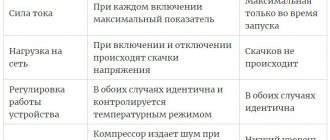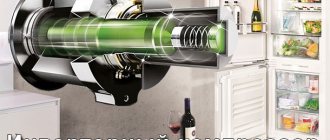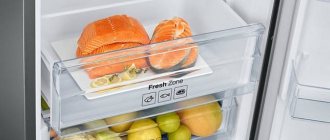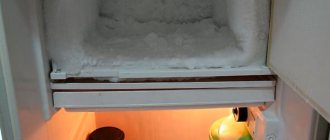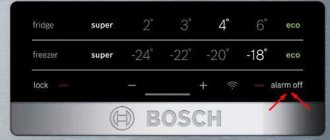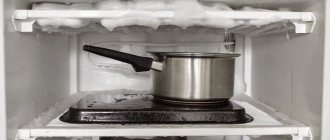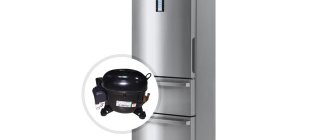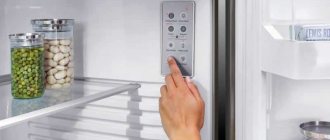Choosing a refrigerator: tips and tricks
There are certain criteria for choosing a refrigerator that you should pay attention to when purchasing:
- number of cameras;
- location of the freezer compartments in relation to the refrigeration compartments (bottom, top, side);
- climate class;
- defrosting system;
- compressor type;
- energy consumption class;
- noise level;
- volume and dimensions;
- manufacturing company;
- additional functions.
All these points will be discussed in detail in the article, which will allow you to quickly select the best model. And we'll start with the number of cameras. The most popular options include single-chamber models (with only a refrigerator compartment or with an additional freezer compartment inside). They are suitable for offices, hotels and cottages. This also includes two-chamber ones (with separate freezer and refrigerator compartments) and three-chamber ones with an additional “freshness zone”, where the temperature ranges from 0 to + 2 ° C (it is intended for storing perishable foods).
Depending on the location of the freezer, there are three types of refrigerators:
- “European” (the freezer is located at the bottom of the appliance, under the refrigerator compartment);
- “Asian” (the freezer is located in the upper part);
- “American” (Side-by-Side type, freezer and refrigerator compartments are side by side).
Refrigerator climate class
To understand what the climate class of a refrigerator means and which of the available ones is better, carefully read the following information. Climatic classes are the parameters of the average ambient temperature values at which the device is planned to be operated. Currently there are 4 of them:
- N (means normal) – from +16оС to +32оС;
- SN (subnormal) – from +10°C to +32°C;
- ST (this is subtropical) – from +18оС to +32оС;
- T (tropical) – from +18оС to +43оС.
The domestic market mainly includes models of classes N and SN. But due to the increase in average air temperature in the summer, some manufacturers began to produce “multi-class” devices with wider temperature limits, for example, N-ST or SN-ST. The correct choice of climate class is important - if the equipment under warranty breaks down, and an expert assessment reveals that the operation was carried out without taking into account the class, the warranty card will be invalid.
"No Frost"
A more modern defrosting system - No Frost (which means “No Frost”) can be used in both the refrigerator and freezer compartments. This system works very simply: the evaporator is placed on top or behind the back wall of the chamber, and cold air is circulated using a special fan. As a result, frost forms only on the evaporator, not on the walls of the device. Every couple of hours the fan stops working and the evaporator turns on. Frost turns into water, which flows into a special tray and evaporates.
Smart Frost system
In combined domestic refrigerators, innovative Smart Frost technology contributes to reduced frost formation on the walls and contents. A refrigerator with this function is called “smart”: it senses the degree of freezing of food.
Refrigerator with Smart Frost system
What is good about Smart Frost technology?
Premium models of such refrigeration devices with smart functions are made from materials with the best performance characteristics. The inner walls and auxiliary surfaces are smooth and easy to clean. Shelves and drawers are removable, which allows you to increase the internal usable volume of the chamber and freeze more products. Manual defrosting of the freezer can hardly be called an advantage of a refrigerator with a smart frost system, and the second disadvantage is the complexity of maintenance and repair.
Before buying, you should think about whether you need an intelligent function or whether it’s easier to choose a clear No Frost refrigerator.
What is Low Frost
In Russian, this system means “low frost.” The evaporator in such refrigerators runs in a circuit throughout the entire freezer compartment and is hidden from view by a plastic wall. Ice simply does not form, but this happens due to the slow and smooth cooling of the air.
Refrigerator with Low Frost system
Operating principle
Features of the frost fishing device:
- the evaporator has no tubes, the walls of the freezer are double-layered;
- freon enters directly into the evaporator and is distributed throughout the entire volume;
- the chamber walls reach the set temperature level gradually and evenly.
with the Low Frost system is noticeably different from conventional models with a tubular evaporator. Along with Low Frost technology, the drip defrosting method can be used.
Advantages and disadvantages
The advantages of Low Frost are few but significant:
- there are no sudden temperature changes, therefore, little condensation;
- defrosting proceeds quickly and with a minimum of melt water;
- low cost and wide range of models.
A relative disadvantage is that this system is designed only in freezers. The layer of ice gradually increases, no matter how evenly the air and food are cooled. Every six months you need to forcefully defrost the unit, completely freeing it of snow.
Do not use sharp objects or forcefully tear off pieces of ice, otherwise important parts will be damaged and the refrigerator will have to be repaired.
Total No Frost
Improved models of refrigerators are produced by LG and Whirlpool. The total know frost program is designed for long-term storage of products in their natural form, without total freezing. The Multi Air Flow ventilation system forces cooled air to spread throughout the chamber and bring products on any shelf and door drawers to the desired temperature. The maximum temperature difference in different areas is no more than one degree.
Refrigerator with Total No Frost system
Linear
A linear compressor is a classic version that operates on the principle of “on-operate-off”. That is, first the motor turns on to lower the temperature to the desired level. Afterwards, a special sensor measures the current temperature and compares it with the set one. If the difference is in the positive direction (that is, when the chamber is warmer than it should be), the system switches to a more intensive operating mode, lowering the temperature to the required level. When the goal is achieved, the compressor turns off, and so on in a circle. This stepwise method of motor operation is associated with significant loads on both the compressor itself and the electrical network.
Inverter
The operating principle of an inverter motor is completely different. The motor turns on, the temperature quickly drops, and then is simply maintained at the required level. That is, the engine operates as softly and smoothly as possible, not turning on and off at certain intervals, but reducing or increasing speed. As a result, there are no temperature fluctuations.
Of course, the presence of an inverter compressor in the refrigerator is associated with both pros and cons during operation. The first category includes:
- low noise level;
- lower energy consumption compared to a linear compressor;
- long service life due to the absence of on/off switching.
The disadvantages include the high sensitivity of the inverter motor to power surges in the network, as well as the fairly high cost of such equipment.
Advantages and disadvantages
No Frost is very popular, but consumers do not stop purchasing refrigerators with a drip system. The fact is that such devices are not ideal, therefore, along with significant advantages, they also have some disadvantages that can significantly affect the choice of a frequently used device for the kitchen.
pros
Advantages of No Frost:
- Such devices are easy to care for and do not require constant defrosting, but it is still worth cleaning and defrosting them a couple of times a year. If used properly, ice will not form in the chambers.
- Condensation does not accumulate in refrigerators.
- Food cools much faster than other models.
- The ability to set different temperatures in certain zones.
- Quickly restore a constant temperature after opening and closing the door.
- Many models with Nofrost have an ultra-fast dry freezing function.
- Optimal intensive circulation of cold air and access to even the farthest areas of the refrigerator.
Minuses
Built-in fans take up useful volume
A device that looks roomy may turn out to be small inside. Consumption of more electricity compared to drip and manual type refrigerators. Most devices with Nofrost are noisy. When choosing, it is important to pay attention to the presence of noise insulation in the separately selected model. Products quickly dry out, so they should be stored in airtight containers. The cost of such refrigerators is much higher than devices with a drip system.
What are the energy consumption classes?
The power consumption of a refrigerator is measured in classes from A to G, where A is the most economical, B, C and D are average, and from E to G are low. To determine the class, a calculation is made of the correspondence between the nominal value (100%) and the actual consumption of a particular category (that is, how much electricity the equipment actually consumes):
- A – less than 55%;
- B – 75%;
- C – 75-90%;
- D – 90-100%;
- E – 100-110%;
- F – 110-125%;
- G – more than 125%.
However, the number of classes is not limited to these 7. The fact is that some manufacturers of refrigeration equipment, in order to minimize the level of energy consumption, introduced the concept of “class Super A” (this is A+, A++). Such refrigerators consume 50% or less electricity of the nominal value. This is achieved by creating high-quality insulation of the walls of the equipment (cold loss is reduced - the compressor works less intensively - energy consumption is lower) and the use of other technologies.
No frost: myths and reality
Manufacturers of refrigeration equipment often look for shortcomings in competitors' products. Many of them are far-fetched. This is how myths appear.
Myth #1: No frost device consumes a lot of electricity
The refrigerator ranks fifth in energy consumption among the most common household appliances after the electric stove, air conditioner, washing machine and iron. But unlike the listed devices, it always consumes electricity while it is plugged in.
No frost refrigerators differ from classic ones in the presence of fans and an automatic defrosting system. Therefore, they actually consume more electricity than drip ones, all other things being equal.
When purchasing a unit, pay attention to its efficiency, which is characterized by its energy consumption class. It shows how much electricity the refrigerator spends to maintain the required temperature in the chambers
The classification of devices by energy consumption is based on the energy efficiency index. This is the ratio of real consumption to estimated consumption, multiplied by 100.
A higher class means less consumption. Class A refrigerators are the most economical. According to the current European regulations, adopted in 2014, refrigerators are distinguished with high, medium and low efficiency. The latter have been discontinued.
The following table will help you choose the right device in terms of energy consumption.
| Energy efficiency class designation | Energy efficiency index | Number of energy consumed per operating cycle | Annual consumption, kW/h* |
| High energy efficiency | |||
| A+++ | until 22 | less than 22% | 125-300 |
| A++ | 22-33 | 27,5% | |
| A+ | 33-42 | 37,5% | |
| A | 42-55 | 48,5% | |
| Average energy efficiency | |||
| B | 55-75 | 65% | 350-550 |
| C | 75-95 | 85% | 600-850 |
| D | 95-110 | up to 100% |
*The column “Annual consumption” shows average values.
If, as an example, we take the worst class D refrigerator in terms of energy consumption, then the cost of its operation for a year at an electricity price of 3 rubles. per kW/h will be 3 rubles. x 850 kW = 2550 rub. A similar calculation for a No Frost unit of class A+++ is 900 rubles.
Electricity consumption will be higher if:
- the refrigerator is overloaded with products, especially hot ones;
- there is a high temperature in the room where the refrigerator is used;
- rubber door seals are worn out;
- magnets do not ensure a tight fit of the doors to the body of the unit;
- doors open frequently and do not close tightly or remain open for a long time;
- The refrigerator is located close to the wall or is located near heating devices.
Myth #2: No frost devices are unreliable
This statement is completely unproven. Of course, the reliability of any technology deteriorates with an increase in the number of elements included in it. Therefore, formally everything is correct, since the refrigerators in question are more complex than others.
However, it is impossible to objectively compare the reliability of units of different types, since in most cases, manufacturers of refrigeration equipment do not provide reliability parameters in the technical specifications. There are also no official statistics on unit failures in available sources.
Myth No. 3: No Frost refrigerators dry out the food stored in them
This problem is easily solved by storing food in containers or using cling film to seal other containers. To combat drying, some use special boxes with a high level of humidity.
Myth No. 4: No frost units create increased noise levels
In fact, this is not true at all. The table below compares the noise levels of refrigerators of different types and manufacturers, comparable in useful volume.
| Brand | Useful volume of the refrigerator, l | Noise level, dB |
| Drip refrigerators | ||
| Liebherr Cef 4025 | 357 | 39 |
| Bosch KGE39AW21R | 351 | 38 |
| ATLANT XM 4624-101 | 347 | 39 |
| Pozis RK-103W | 340 | 40 |
| Refrigerators “No frost” | ||
| Liebherr CBNPgw4855 | 344 | 37 |
| Samsung RB-37 K622154 | 367 | 37 |
| Mitsubishi Electric MR - CR46G-PWH-R | 406 | 37 |
| LG GA-B499YVQZ | 394 | 39 |
The table shows that even the No Frost refrigerator model Mitsubishi Electric MR - CR46G-PWH-R, which has the largest volume of compartments compared to other models - 406 l, creates a noise level less than any of the drip refrigerators reviewed - 37 dB .
For comparison: the sensitivity threshold of the human ear is 20 dB. The noise level generated by a wall clock is 30 dB, a muffled conversation is estimated at 40 dB. Thus, all the refrigerator models listed above create noise that is less than a muffled conversation. It is unlikely that it will bother anyone much.
What you need to know about noise levels
GOST 16317-87 gives an unambiguous answer to the question of what noise level a refrigerator should have - no more than 53 dB. In addition, the relevant documents indicate a special scale according to which the noise level of modern household appliances is divided into three categories:
- low – from 25 to 24 dB;
- normal – from 35 to 44 dB;
- high – more than 45 dB.
In addition, for certain modifications of refrigeration equipment, individual noise parameters are indicated, for example, with the No Frost system - from 44 to 47 dB. The operating noise level of a particular model is indicated in the technical data sheet, as well as on a sticker on the back surface of the device.
Forced air circulation systems in a refrigeration unit
https://www.elremont.ru
Many models of modern refrigeration units are characterized by the presence of forced air circulation systems designed for the following purposes:
- pumping air through an evaporator located outside the refrigerator or freezer chamber to prevent the formation of frost in the chamber itself (No Frost system and its modifications);
- ensuring uniform air circulation in the volume of the refrigerator or freezer to create a uniform temperature field.
No Frost System
The system of forced air pumping through the evaporator, located outside the freezer, was developed and patented by specialists from the Zerowatt factories, part of the Candy industrial group. Under the name Frost Free, this system can be found in refrigerators of the brands of this group: Candy, Hoover, Iberna. Recently, along with Frost Free, different manufacturers are increasingly using the more generally accepted name No Frost, and by Frost Free, Candy specialists mean a forced ventilation system only in the freezer compartment.
The “No Frost” system is shown in the example of an AEG upright freezer in Fig. 1.
Rice. 1
No Frost system of upright freezer:
| 1 - fan; | 4 - external heat exchanger (refrigerant condenser); |
| 2 - evaporator; | 5 — water condensate drain; |
| 3 - compressor; | 6 — condensate collection pan |
With the help of fan 1, cold air is evenly distributed throughout the volume of the compartment and carries moisture (which causes the formation of frost) to the evaporator 2 located outside the freezer, where the moisture freezes. The refrigerator's automation periodically defrosts the evaporator (the fan stops running during this time), the melt water flows into tray 6 and evaporates. This prevents ice from forming in the freezer compartment and eliminates the need for defrosting.
A number of models have a system of channels for supplying air not only to the freezer, but also to the refrigerator compartment (Fig. 2.).
Rice. 2.
No Frost system of a two-chamber refrigerator.
To designate such a scheme, the terms Total No Frost, Full No Frost are used.
The presence of the “No Frost” system leads to increased energy consumption of the refrigerator compared to a static cooling system. In table 1 shows the parameters of models that are similar in chamber volume, but differ in the cooling system. It can be seen that the appearance of the “No Frost” system lowers the energy consumption class of the model by 1 - 3 steps. A slight reduction in the volume of the freezer compartment is also noticeable due to the installation of the “No Frost” system.
Volume - tips for choosing the right size
There is such a thing as the “useful volume of a household refrigerator,” which differs from the general one by several tens of liters, since shelves and partitions take up a lot of space. This is what you should pay attention to when choosing a specific model.
Use the following calculation as a guide. The average volume per person is 120 liters. For each subsequent family member, 60 liters are added. That is, for two people a model with a useful volume of 180 liters will be enough, for three – 240, for four – 300. And if it is customary for a family to buy food for future use or there are often guests in the house, it is worth adding another 60 liters to the volume “in reserve” . As for the sizes, there is a conditional classification of modern models of refrigeration equipment:
- small devices (1-1.5 meters high, up to 59 cm wide) are often installed in offices, hotel rooms, country houses, and daily rental housing;
- standard (1.7-1.85 meters high, 60-65 cm wide) are designed for a regular kitchen, suitable for use by a family of 2-4 people;
- overall, about 2 meters high and about 80 cm wide (as a rule, these are Side-by-Side appliances) - an excellent choice for spacious kitchens, as well as studio apartments.
Myths and truth about No Frost refrigerators
There are a number of misconceptions about No Frost technology. Let's look at them.
Opinion No. 1 – No Frost refrigerators are harmful to health
Adherents of this opinion believe that this system uses a special freon, which is very toxic. In fact, No Frost refrigerators use the same refrigerant as others. In addition, freon circulates through a completely sealed closed system, and you simply physically cannot inhale it.
The only case when freon can leave the system is if the line breaks. But there is very little of this gas in the system. In addition, it is much heavier than air, and there is no way you can breathe it in.
Opinion No. 2 – No Frost refrigerators dry food
This is partly true. The fact is that the more often you use the refrigerator, the more often the circulation system turns on. And air currents contribute to the weathering of products. Of course, if something is stored for a day or two, it won't have much effect.
To avoid chapping, wrap food in cling film and store in sealed containers or plastic containers. The operation of the system will not affect the shelf life of whole fruits and vegetables.
Opinion No. 3 – No Frost refrigerators do not need defrosting
In most models, the evaporator defrosts naturally. When the doors are closed and the chamber maintains a constant temperature for a long time, the frost on the evaporator melts. If you use your refrigerator frequently, the following may happen.
The refrigerator will cool the chamber more intensively, which is why the ice on the evaporator will not have time to thaw. This will also happen if the refrigerator door does not close completely or the seals do not fit tightly. In this case, warm air will enter the refrigerator and an ice “coat” will build up on the evaporator.
If you notice that the refrigerator has begun to cool poorly, you should defrost it. And in general, once or twice a year it wouldn’t hurt to give him a rest. At least to carry out general cleaning in the cells.
Opinion No. 4 - the volume of the No Frost refrigerator is smaller than usual, with a drip system
This is both true and false. The fact is that manufacturers indicate the useful volume in the product characteristics. That is, if the specification states that you have a refrigerator with a capacity of 250 liters, then it will be so, regardless of the technologies used.
The nuance is that, with the same volume, No Frost refrigerators have slightly larger dimensions than drip refrigerators. It turns out that with the same dimensions, a unit with a drip system will have a larger usable volume. Therefore, the question can be looked at from two sides.
Features and additional functions of Liebherr refrigerators
When it comes to choosing a refrigeration equipment manufacturer, many naturally prefer equipment from the German brand Liebherr. And this is not surprising, because the main difference between Liebherr household appliances and analogues is that they are created taking into account the wishes and requirements of consumers. This applies to both the design and functionality of the devices. The key features of refrigerators from Liebherr include:
- the widest model range, which includes both “economy” (with a standard set of options) and “premium” (with a large number of different functions) class devices;
- actual service life is 10 years or more, warranty is 3 years;
- introduction of innovative technologies in the production of devices.
The last point is worth dwelling on in more detail. If we talk about the design features of the models of this brand, it is necessary to note at least 4:
- Built-in shock-absorbing SoftSystem door closer for the smoothest door closing. And if the opening angle is less than 45 degrees, the door closes automatically.
- IceMaker with direct water connection for constant replenishment of ice in two compartments.
- MagicEye touch control system, which allows you to maintain the selected temperature with an accuracy of a degree, as well as easily control the operation of the refrigerator.
- SmartSteel coating applied to the doors of many Liebherr models with a stainless steel body.
It protects the device from mechanical damage (such as scratches) and fingerprints, and is also very easy to clean. There are other Liebherr technologies that deserve close attention if you are considering purchasing a refrigerator from this brand.
Low Frost System
There are many technology terms that can easily get confusing. During the purchase, we carefully study the device: its functions, quality, appearance. You should understand the features of household appliances in order to know which specific product is needed. Refrigerators are equipped with different defrosting systems, and each of them has distinctive features. One of the systems is low frost.
Translated from English “low frost” - “low frost”. This is the main functional feature. The design of the refrigerator is designed in such a way that the food cools simultaneously and there are no warm areas left in the chamber.
The evaporator is located around the entire perimeter of the inner walls of the freezer, so that large ice build-ups do not form. The system minimizes temperature changes, and the cold inside the refrigerator covers the walls with only a thin layer of ice, which is almost invisible.
It is worth noting that the Love Frost technology is used only in a separate refrigeration compartment (freezer), since this is where there is a risk of detecting growths from a thick layer of ice. Thanks to the evaporator, uniform humidity is maintained, and you don’t have to worry about the quality of the food. Also, if the power goes out in the house, you won’t have to worry about a possible flood.
Evolution of low frost
Improved refrigerator models continue to amaze every year. Modern units complement everything with new functions that make the process of operating equipment more comfortable. One of the features is less frost. What's that in the refrigerator?
To begin with, it is worth noting that the operating principle of such a system is not particularly advertised, since this is only a modernization of low frost technology. Less Frost in the refrigerator functions in a similar way. Its main difference is the enhanced thermal insulation of the body, which increases energy efficiency.
The phrase translated from English means “frost-free.” The principle of operation of the technology is to prevent the formation of ice, both on the walls of the freezer chamber and on the products. The function does not imply a complete absence of ice, but the need to manually defrost the refrigerator is halved.
The main developer of the Love Frost system is the German company Bosch. The range of devices of this brand is very wide. Today, the system is also used by other manufacturers of household appliances, such as AEG, Siemens and Gorenje.
To make the selection process easier, consider the rating of the best refrigerators equipped with LowFrost technology:
- Bosch LOW FROST KGV39VK23R has a stylish design and high-quality assembly. The main advantages of the model are spaciousness and quiet operation. The disadvantages include the fact that the unit takes a long time to adapt to the ambient temperature.
- SHARP SJ-B132ZR-WH is a model that has no disadvantages. High quality materials and workmanship indicate the durability of the equipment. It features good equipment and quiet operation.
- SIEMENS KI 87SAF30 R is a refrigerator that is made of stainless steel and other high-quality materials. Features of the unit are the ability to be built into a kitchen set and a fruit drawer with a separate setting mode. The disadvantages include the small volume. The refrigerator holds 272 liters, while its competitors hold more than 300. It is not suitable for a large family.
- The AEG SCS61800FF is equipped with electronic control with display, a separate freshness zone for delicacies and a super-freeze function. The assembly and quality of materials are excellent. There is a spacious compartment for fruits and vegetables, where a watermelon can easily fit. Despite the large number of advantages, the refrigerator still has a drawback - the unit is a little noisy. But this factor is individual for each consumer.
BioFresh technology
The special BioFresh chamber provides ideal conditions for long-term storage of perishable products. Due to the optimal level of humidity and maintaining the temperature at 0°C, dairy products, vegetables, fruits, herbs, fish, meat retain the maximum amount of vitamins, freshness and appetizing appearance three times longer than when stored in a conventional refrigerator.
At the same time, Liebherr's BioFresh technology offers two options for storing food. You should store fruits, berries, vegetables and herbs in a HydroSafe container with high humidity mode. And in the DrySafe low-humidity container, dairy products, meat and fish are perfectly preserved.
What does Low Frost mean in a refrigerator?
The phrase is translated into Russian as “low frost.” The technology involves placing the evaporator behind the internal walls of the freezer along the entire length of the boundaries. It is considered as an intermediate form of a drip cooling system, operating on the “freeze-thaw” principle, and No Frost, which eliminates manual defrosting of the unit.
Mechanism of action of Low Frost:
- the freezer is equipped with double walls, so the evaporator has no tubes;
- the refrigerant is supplied directly inside the heat exchange element, where it evaporates, and fills the entire volume of the refrigerator part;
- There is a gradual decrease in the temperature of the evaporator, which allows the walls of the freezer to cool evenly.
In comparison with defrosting systems of older units, the following advantages of Low Frost technology can be highlighted:
- minimal temperature changes that do not allow ice build-up to form on the walls of the refrigerator;
- slow and uniform cooling of the inner surface of the freezer;
- the difference between the air temperature inside the chamber and its walls is insignificant;
- the thin thickness of the ice layer makes it almost invisible. There are no problems with pulling out drawers or accessing products;
- absence of frost inside the chamber due to the low concentration of condensate;
- complete defrosting is carried out no more often than 1 r. in year. The time required for the procedure is 2 hours. Upon completion, hygienic cleaning is carried out;
- creating conditions that allow you to maintain the freshness of products for a long time by supplying cold behind the camera machine.
Some users also consider the need for defrosting to be a disadvantage, since condensation forms on the inner surface of the refrigerator compartment.
The great popularity of refrigerators with Low Frost is due to the insignificant impact of the cost of technology on the price of the unit, minimal changes in design, and an increase in internal space in comparison with No Frost.
SuperCool mode for the refrigerator compartment
This is an automatic mode for rapid cooling of products placed in the refrigerator compartment. When activated, the temperature drops to +2°C (and in devices with the BioFresh function - to +4°C). This option is especially relevant in cases where you need to quickly cool a large amount of food. The mode is also useful when too many products are loaded into the refrigerator at once (for example, upon arrival from the supermarket).
The function allows you to avoid unwanted increases in temperature and humidity levels of those products that were previously placed in the refrigerator compartment. SuperCool mode turns off after activation after 6 hours.
Rules for caring for the No Frost refrigerator
When using any equipment, caring for it is important.
Here are some care tips:
- Defrosting in hot weather is undesirable due to the high load on the compressor.
- First you need to know the cooling system. In a single-circuit unit, the unit is completely turned off; in a double-circuit unit, one chamber is defrosted.
- If necessary, you can speed up the defrosting process with a hairdryer. Warm, directed air will quickly remove excess water.
- The entire defrosting takes on average 2 hours.
- When washing, you should not forget about the back wall, a lot of dust accumulates there.
- To avoid damaging the inner wall, do not use sharp objects such as a knife when removing frost.
- At least 12 hours must pass between turning off and turning on the equipment, since when quickly turned on again, there is a sharp rise in pressure in the condenser, which can lead to breakdown.
- It is prohibited to use household chemicals when washing equipment. For the outside, you can use non-abrasive products.
- The refrigerator itself should be located at a distance from walls and radiators, in a place where the sun's rays will not fall on it.
- To avoid chapping, before putting food away, it is advisable to pack it in cling film or a container.
- Do not place hot foods to avoid temperature changes.
The cleaning process itself takes place in the following order:
- Unplug, get groceries.
- Clean the ventilation holes with cotton swabs. The panels cannot be removed as this will void the warranty.
- Wash drawers and shelves.
- Treat seals.
- Wipe inside with a damp cloth.
- To ventilate the chamber, it is advisable to leave the door open for a while.
- Lay out the products, connect to the network.
SuperFrost mode for freezer
This automatic mode is designed to quickly freeze large quantities of food placed in the freezer compartment of a Liebherr refrigerator. It allows freezing at temperatures of -32...-38°C to better preserve the quality of meat, vegetables, and fruits, since they are frozen evenly and to the full depth. When this mode is activated, food does not become covered with a crust of ice and does not freeze to the walls of the freezer. And when defrosted, they do not lose moisture in the future, maintaining their natural structure and color.
The option is disabled automatically after the freezing process is completed.
